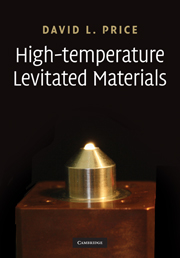Refine search
Actions for selected content:
106095 results in Materials Science
MEMS for In Situ Testing—Handling, Actuation, Loading, and Displacement Measurements
-
- Journal:
- MRS Bulletin / Volume 35 / Issue 5 / May 2010
- Published online by Cambridge University Press:
- 31 January 2011, pp. 375-381
- Print publication:
- May 2010
-
- Article
- Export citation
Nanostructured Lithium Sulfide/Silicon Electrode Design Quadruples Theoretical Specific Energy of Rechargeable Batteries
-
- Journal:
- MRS Bulletin / Volume 35 / Issue 5 / May 2010
- Published online by Cambridge University Press:
- 31 January 2011, p. 339
- Print publication:
- May 2010
-
- Article
-
- You have access
- Export citation

High-Temperature Levitated Materials
-
- Published online:
- 23 April 2010
- Print publication:
- 06 May 2010
Have You Ever Wanted to Be a Board Member?
-
- Journal:
- MRS Bulletin / Volume 35 / Issue 4 / April 2010
- Published online by Cambridge University Press:
- 31 January 2011, p. 261
- Print publication:
- April 2010
-
- Article
-
- You have access
- Export citation
Progress in Carbon Nanotube Electronics and Photonics
-
- Journal:
- MRS Bulletin / Volume 35 / Issue 4 / April 2010
- Published online by Cambridge University Press:
- 31 January 2011, pp. 306-313
- Print publication:
- April 2010
-
- Article
- Export citation
13 - Forces at work: a miscellany of issues
- from Part II - Self assembly
-
- Book:
- Molecular Forces and Self Assembly
- Published online:
- 06 January 2011
- Print publication:
- 01 April 2010, pp 348-359
-
- Chapter
- Export citation
Index
-
- Book:
- Molecular Forces and Self Assembly
- Published online:
- 06 January 2011
- Print publication:
- 01 April 2010, pp 360-365
-
- Chapter
- Export citation
Electrochemical synthesis and properties of layer-structured polypyrrole/montmorillonite nanocomposite films
-
- Journal:
- Journal of Materials Research / Volume 25 / Issue 4 / April 2010
- Published online by Cambridge University Press:
- 31 January 2011, pp. 658-664
- Print publication:
- April 2010
-
- Article
- Export citation
3 - Electrostatic forces in electrolytes in outline
- from Part I - Molecular forces
-
- Book:
- Molecular Forces and Self Assembly
- Published online:
- 06 January 2011
- Print publication:
- 01 April 2010, pp 35-64
-
- Chapter
- Export citation
Tufts Polymer Laboratory Silently Buzzes with Enthusiasm
-
- Journal:
- MRS Bulletin / Volume 35 / Issue 4 / April 2010
- Published online by Cambridge University Press:
- 31 January 2011, pp. 269-270
- Print publication:
- April 2010
-
- Article
-
- You have access
- Export citation
Microstructure and electronic behavior of PtPd@Pt core-shell nanowires
-
- Journal:
- Journal of Materials Research / Volume 25 / Issue 4 / April 2010
- Published online by Cambridge University Press:
- 31 January 2011, pp. 711-717
- Print publication:
- April 2010
-
- Article
- Export citation
Structurally complex metallic coatings in the Al-Cu system and their orientation relationships with an icosahedral quasicrystal
-
- Journal:
- Journal of Materials Research / Volume 25 / Issue 4 / April 2010
- Published online by Cambridge University Press:
- 31 January 2011, pp. 764-772
- Print publication:
- April 2010
-
- Article
- Export citation
Analysis of indentation creep
-
- Journal:
- Journal of Materials Research / Volume 25 / Issue 4 / April 2010
- Published online by Cambridge University Press:
- 31 January 2011, pp. 611-621
- Print publication:
- April 2010
-
- Article
- Export citation
Fabrication and characterization of sol-gel-derived zinc oxide thin-film transistor
-
- Journal:
- Journal of Materials Research / Volume 25 / Issue 4 / April 2010
- Published online by Cambridge University Press:
- 31 January 2011, pp. 695-700
- Print publication:
- April 2010
-
- Article
- Export citation
Ultrananocrystalline and Nanocrystalline Diamond Thin Films for MEMS/NEMS Applications
-
- Journal:
- MRS Bulletin / Volume 35 / Issue 4 / April 2010
- Published online by Cambridge University Press:
- 31 January 2011, pp. 281-288
- Print publication:
- April 2010
-
- Article
- Export citation
Enhancing the fatigue property of rolled AZ31 magnesium alloy by controlling {10-12} twinning-detwinning characteristics
-
- Journal:
- Journal of Materials Research / Volume 25 / Issue 4 / April 2010
- Published online by Cambridge University Press:
- 31 January 2011, pp. 784-792
- Print publication:
- April 2010
-
- Article
- Export citation
1 - Reasons for the enquiry
- from Part I - Molecular forces
-
- Book:
- Molecular Forces and Self Assembly
- Published online:
- 06 January 2011
- Print publication:
- 01 April 2010, pp 3-16
-
- Chapter
- Export citation
Thermoelectric properties and spark plasma sintering of doped YB22C2N
-
- Journal:
- Journal of Materials Research / Volume 25 / Issue 4 / April 2010
- Published online by Cambridge University Press:
- 31 January 2011, pp. 665-669
- Print publication:
- April 2010
-
- Article
- Export citation
2 - Different approaches to, and different kinds of, molecular forces
- from Part I - Molecular forces
-
- Book:
- Molecular Forces and Self Assembly
- Published online:
- 06 January 2011
- Print publication:
- 01 April 2010, pp 17-34
-
- Chapter
- Export citation
A physically based model for indenter tip shape calibration for nanoindentation
-
- Journal:
- Journal of Materials Research / Volume 25 / Issue 4 / April 2010
- Published online by Cambridge University Press:
- 31 January 2011, pp. 735-745
- Print publication:
- April 2010
-
- Article
- Export citation
